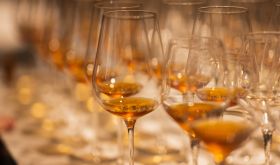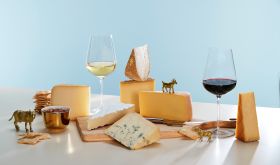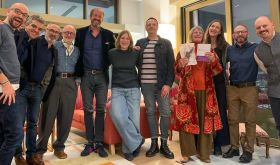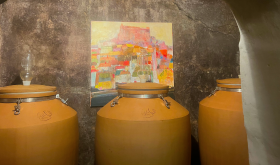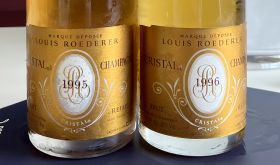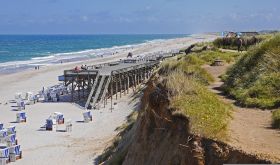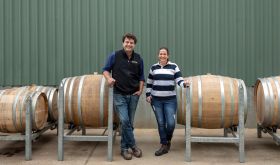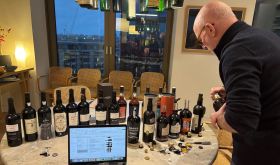この記事は、できるだけ早くお届けするためにまずAIで翻訳したものです。今後はAIに教育を行うことでその精度を上げること、それと並行し翻訳者が日本語監修を行った記事と、AI翻訳のみによる和訳記事を明確に分けることで、読者の皆様の利便性を最大限に高めることを目指しています。表現に一部不自然な箇所がある場合があります。ご了承ください。
故ベッキー・ワッサーマン(Becky Wasserman)は、現代ブルゴーニュの恩人的存在だった。彼女は若いヴィニュロンたちの世代以上を育て上げ、最終的には極めて受容的になったアメリカ市場に彼らのワインを売り込んだのである。
2003年、彼女は私に20代の青年について話してくれた。その青年は最近ヴォーヌ・ロマネに到着し、家族のワイン・エステートを取り戻そうとしていた。その結果生まれた記事を、FTの編集者たちは当時放映中のテレビ番組にちなんで「ベレールのフランス公子」(The French prince of Belair)と題した。
ルイ・ミシェル・リジェ・ベレール(Louis-Michel Liger-Belair)は実際には公子ではなく伯爵であり、革命後の称号剥奪を受けた多くのフランス人とは異なり、その事実を極めて強く意識している。4月下旬、彼が2023ヴィンテージを潜在的バイヤーたちに紹介するためにロンドンを訪れていた際に私は彼と再会し、わずかなブドウの樹しか持たない駆け出しワイン生産者からブルゴーニュのエミナンス・グリース(黒幕)と言っても過言ではない地位まで上り詰めた彼の歩みを探った。
初めて彼と会った時以上に、そしてその後毎年、塔の螺旋階段を上った2階にあるますます豪華になる彼のオフィスで最新ヴィンテージをテイスティングした際以上に、私が受けた印象は、貧困と第7代コント・リジェ・ベレールとしての義務に憑りつかれている人物というものだった。
この貴族の家系の歴史における大きな出来事は、ブルゴーニュ最上のブドウ畑60ヘクタール(148エーカー)の所有権を失ったことである。その中にはラ・ロマネ(La Romanée)という非常に栄光ある畑が含まれており、その名前は村の名前ヴォーヌに付け加えられたほどだった。これは、ル・シャンベルタン(Le Chambertin)畑の地位ゆえにジュヴレがジュヴレ・シャンベルタン(Gevrey-Chambertin)として知られるようになったのと同様である。それだけでなく、彼らは非常に成功したワイン商を経営しており、19世紀にはロシア、アメリカ、香港に相当量のワインを出荷していた。
しかし1933年、アメリカの禁酒法と世界大恐慌の中で、一家はほぼ全てを売却せざるを得なくなった。初代コント(ナポレオンの将軍の一人)が1815年に購入したブルゴーニュの住居、シャトー・ド・ヴォーヌ・ロマネは荒廃の一途をたどった。
ルイ・ミシェルの父ヘンリー(Henry)も陸軍将軍となったため、ルイ・ミシェルは放浪的な少年時代を過ごした。しかし8歳の時点で既に、家族が休暇を過ごすヴォーヌに住みたいと考えていた。「私が唯一の男の子で、3人の姉妹がいたため、シャトーは私のものになることは常にわかっていました。息子のヘンリーが第8代コントになることを知っているのと同じです。」
ワインを極貧と結び付けていた故父ルイ・ミシェルは、息子がワインを造りたがることに明らかに反対し、そのようなリスクのある事業に着手する前に農学エンジニアの資格を取得するよう主張した。
リジェ・ベレールは2000年、26歳でヴォーヌにワイン造りのために到着した。ディジョンで醸造学を学んだものの、1933年の公開オークションという屈辱から祖父と大叔父によって救われた、元々の家族ブドウ畑所有地のごく一部しか持っていなかった。ブドウの樹は小作農に貸し出されており、例えばラ・ロマネの生産物はネゴシアンのブシャール・ペール・エ・フィス(Bouchard Père et Fils)による販売契約下にあった。
しかし時間をかけて、彼は徐々にラ・ロマネを含む多くの元の所有地から、ワインを栽培し、醸造し、販売する権利を再取得してきた。ラ・ロマネは2エーカー(0.8ヘクタール)のグラン・クリュで、最も有名な同名のグラン・クリュを所有するドメーヌ・ド・ラ・ロマネ・コンティ(DRC)のすぐ上に位置している。
ドメーヌ・デュ・コント・リジェ・ベレールのワインは精密さと増大する洗練さを示しており、現在ではブルゴーニュで最も熱心に求められるワインの一部となっている。当初は生活の糧を得るため、彼は不動産鑑定士の資格を取得した。これにより彼は、コート・ドール、特に北部のコート・ド・ニュイにおけるブドウ畑売買の仕組みに比類のないアクセスを得ることができた。これが彼のエステートの異常に安定した拡大ペースに間違いなく寄与している。
これらの売買は、ナポレオン法典が財産を生存する家族全員に平等に相続することを定めており、全員一致は稀な財産であるため、しばしば家族争いの結果である。長年にわたり、ブルゴーニュの様々な取引について風の便りで聞く中で、リジェ・ベレールがどれほど頻繁に関わっているように見えるかに私は驚いてきた。
彼はLVMHによるグラン・クリュ・エステート、クロ・デ・ランブレイ(Clos des Lambrays)の買収に関与していたことを認めた。グローバル・コングロマリットの参入は、すべてのブルゴーニュ人に広く歓迎されたわけではなかったが、リジェ・ベレールの私に対するコメントは、「まあ、少なくとも彼らはフランス人ですから」だった。しかし彼はまた、最近のアジアやアメリカからのブドウ畑購入者の流入についても冷静である。「今ブルゴーニュで起きていることは、25年前にボルドーで起きたことと同じです。とにかく、貧しいフランス貴族が裕福なアメリカ人の妻を求めた1世紀前と全く同じです。」
彼の最近の個人的な大成功の一つは、2021年末の取引で、価値あるドメーヌ・ラマルシュ(Domaine Lamarche)のワインの一部を2050年まで栽培、醸造、販売する権利を得たことであり、これによって彼のプルミエ・クリュとグラン・クリュの所有地が大幅に増加した。
私は彼に、返還の理念に触発されたのか、ヴォーヌの魅力なのか、ヴィニュロンの生活なのか、何に動機付けられたのかを尋ねた。我々の会話で初めて、彼は間を置き、苦笑いをして、フロイト的分析に使えそうなソファの方を手で示した。「はい」と彼は認めた。「確かに返還という概念がありました。私の父ヘンリーは1928年、ブルゴーニュ・ワインの最も裕福な家族の一つに生まれました。1933年に家族会社は完全に崩壊し、我々は最も貧しい家族の一つになりました。私は我々の名前を、かつてあった場所であるワイン業界の頂点に復活させたかったのです。」
その目的のために、彼はネゴシアンのボアセット(Boisset)から元の家族ワイン商会社を買い戻し、現在は香港在住の息子が考案した慈善的仕組みの参加者によって造られる地域ブルゴーニュに使用している。この仕組みによって、ブルゴーニュへの若い新参者がメンタリングを受ける。「地元のワイン家族の子供ではない人々の才能を維持し、育成するという考えです。彼らは自分のブランドを構築でき、運が良ければ6年程度で、彼らを支援してくれる人を見つけることができます。」
リジェ・ベレールシニアは若い人々を非常に重視している。「彼らが我々の未来です。」彼はワインやホスピタリティ業界で活躍するロンドンの様々な人々のためのランチを主催したばかりだった。「我々は彼らになぜワインを飲まないのかを尋ね、将来の市場をより良く理解する必要があります。私はニューヨークとパリでも同様のことをしました。70代、80代のコレクターから若い飲み手に移行しなければなりません。これは大きな変化です。そしてチェスのようなものです。2手先を読む必要があります。」
ブルゴーニュをよりアクセスしやすくするために彼が取った手段の一つは、世界的に有名なワイン生産者の群れが住む眠い村ヴォーヌにワイン・バーを開くことだった。彼は幼馴染のジャン・ニコラ・メオ(Jean-Nicolas Méo)、ジャン・イヴ・ビゾ(Jean-Yves Bizot)、パスカル・ミュニュレ(Pascal Mugneret)などの地元の人々を説得し、ラ・キュヴリ・ド・ヴォーヌ(La Cuverie de Vosne)で最もささやかなマークアップでワインを販売してもらっている。
ブルゴーニュの議論は価格の問題を避けて通れない。限られた供給と最近まで無制限だった需要のおかげで、ブルゴーニュの価格は急騰した。ラ・ロマネは流通市場でボトル1本数千ポンドで価格設定されており、DRCのワインと肩を並べている。リジェ・ベレールは2018年から2020年にかけて価格を大幅に上昇させたが、公平を期すために言えば、彼のイギリスのインポーターであり、ブルゴーニュ専門家であるジャスタリーニ&ブルックス(Justerini & Brooks)のジャイルズ・バーク・ガフニー(Giles Burke-Gaffney)が指摘するように、他の一部の人々とは異なり、リジェ・ベレールは単に一律の値上げを押し付けるのではなく、顧客と連携して価格を決定している。
私はそのような価格を正当化するのは困難だと思っただろうが、リジェ・ベレールは説明を試みた。「価格がこれほど高くなったのは私のせいではなく、市場のせいです。我々がビジネスのシェアを持つ必要があるのは、何よりも子供たちの相続税を考えなければならないからです。商人にとってワインを売るのは2分です。我々がそれを造るには3年かかります。」
2012年にエステートに加わったものの一つは、ニュイ・サン・ジョルジュ(Nuits-St-Georges)のクロ・デ・グランド・ヴィーニュ・プルミエ・クリュ(Clos des Grandes Vignes Premier Cru)のシャルドネの樹だった。私は彼に、現在広く喧伝されている赤ワインから白ワインへの移行を考慮して、より多くの白ワイン用ブドウ畑を追加する誘惑はないかと尋ねた。彼は力強く首を振った。ブルゴーニュの最上の白ワインは全て、彼のコート・ド・ニュイの南のコート・ド・ボーヌで栽培されているという事実を認識している。「そんなに遠くにブドウ畑を持ちたくありません。テラスから自分のブドウ畑を見ることができるのが好きです。シャンベルタン(北に車で10分)のレンタルのオファーを断ったのは、私のルーツはヴォーヌだからです。2006年に初めてニュイのプルミエ・クリュ、オー・クラス(Aux Cras)を持った時にこのことを学びました。全ての顧客がまずヴォーヌのワインを欲しがりました。それに、赤ワイン造りは短距離走です:45日間、毎日ワイナリーにいることになります。白ワイン造りはマラソンです:3ヶ月の作業で、週末に離れることさえできません。」彼とパリ出身の妻コンスタンス(Constance)は、エヴィアンでの週末の逃避行を大切にしている。
彼は間を置いて観察した。「両方の色で本当にトップレベルのブルゴーニュ・エステートを5つでも挙げるのは困難でしょう。とにかく、私はヴォーヌ・ロマネ出身です!」赤は確実に彼のシグネチャー・カラーであり、彼のズボン全てに至るまでそうで、スローン・レンジャー・スタイルで淡いピンクから彼がボルドー・レッドと呼ぶ色まで様々である。「こぼした時に便利です。」
彼は今やコート・ドール全体で非常によく知られているため、その中心地ボーヌの市場ではなく、意図的にその北のディジョンの市場で匿名で買い物をしている。そして2008年の彼のビオディナミ栽培への転換は、コート・ド・ボーヌの多くの既存の実践者ではなく、当時ロワールのドメーヌ・ユエ(Domaine Huet)にいたノエル・パンゲ(Noël Pinguet)に触発された。「彼は数学者です」と、ヴォーヌのエンジニアは承認の意を込めて指摘した。
ワイン造りをまだ学んでいた時、彼はナパ・ヴァレーのファー・ニエンテ(Far Niente)で働き、その後オレゴンのローズ&アロー(Rose & Arrow)とチリのフランソワ・マソック(François Massoc)のアリストス・レーベル(Aristos label)をアドバイスしたが、2018年に両方のコンサルタント業務を諦めた。「私は自分のエゴのためにそれをやっていたと気づきました。最終的に、エステートはかなり急速に上昇していたが、その後上昇カーブが鈍化し、エステートに集中すべきだと気づきました。それは良い選択でした。なぜなら、それ以来カーブを上げることができたからです。」そのカーブはおそらくユーロで測定されているのだろう。
リジェ・ベレールのクリマ
括弧内はドメーヌ・デュ・コント・リジェ・ベレールのデビュー・ヴィンテージ。クリマとモノポールの説明については下記の基本に立ち返るを参照。
村名ワイン
ヴォーヌ・ロマネ、ラ・コロンビエール(La Colombière)(2000)
ヴォーヌ・ロマネ、クロ・デュ・シャトー(Clos du Château)、モノポール (2000)
ニュイ・サン・ジョルジュ、レ・ラヴィエール(Les Lavières)(2006)
ヴォーヌ・ロマネ (2006)
ニュイ・サン・ジョルジュ(クロ・デ・グランド・ヴィーニュの若い樹)(2017)
ヴォーヌ・ロマネ、オー・レア(Aux Réas)(2022)
プルミエ・クリュ
ヴォーヌ・ロマネ、ショーム(Chaumes)(2000)
ヴォーヌ・ロマネ、オー・レニョ(Aux Reignots)(2002)
ニュイ・サン・ジョルジュ、オー・クラス(Aux Cras)(2006)
ヴォーヌ・ロマネ、オー・ブリュレ(Aux Brûlées)(2006)
ヴォーヌ・ロマネ、レ・プティ・モン(Les Petits Monts)(2006)
ヴォーヌ・ロマネ、 レ スショ(Suchots)(2006)
ニュイ・サン・ジョルジュ・ブラン、クロ・デ・グランド・ヴィーニュ、モノポール (2012)
ニュイ・サン・ジョルジュ、クロ・デ・グランド・ヴィーニュ、 モノポール (2012)
ヴォーヌ・ロマネ、 ラ クロワ・ラモー(Croix Rameaux)(2022)
ヴォーヌ・ロマネ、 オー マルコンソール(Malconsorts)(2022)
グラン・クリュ
ラ・ロマネ (2002)、モノポール (2006)
エシェゾー(Échezeaux)(2006)
クロ・ヴージョ(Clos Vougeot) (2015)
グラン・エシェゾー(Grands Échezeaux)(2022)
基本に立ち返る
| ブルゴーニュのグラン・クリュとは何か? |
|
ブルゴーニュはボルドーとは全く異なって分類されている。ボルドーではシャトー、つまり生産者がランク付けされるのに対し、ブルゴーニュでは個々のブドウ畑、つまりクリマがランク付けされる。これらのクリマは、それぞれがわずか数列のブドウの樹を所有する多くの異なる所有者を持つ場合がある。単独所有者を持つブドウ畑はモノポールとして知られ、コント・リジェ・ベレールのラ・ロマネは全てのうち最小のモノポールであり、フランス最小のアペラシオンである。
これはまたグラン・クリュ、ブルゴーニュの最高ランクとしても分類されている。現在コート・ドールには32しかなく、白ワイン用が7つ、コート・ド・ボーヌに赤ワイン用が1つ(コルトン)、残りはコート・ド・ニュイの赤ワイン用である。ただし昇格について常に噂がある。(完全なリストについては、『ワイン・オックスフォード・コンパニオン』のブルゴーニュの項目を参照。)
ランキングで次に位置し、通常はそれほど目を見張るほど高価ではないのがプルミエ・クリュである。これらははるかに多く、それぞれが一般的に特定の村と関連している。例えば、ヴォーヌ・ロマネ、レ・スショ PC または1er cru は、ヴォーヌ村のプルミエ・クリュであるスショを意味する。これらは評判において非常に異なり、シャンボール・ミュジニー(Chambolle-Musigny)のレ・ザムルーズ(Les Amoureuses)やジュヴレ・シャンベルタン(Gevrey-Chambertin)のクロ・サン・ジャック(Clos St-Jacques)などの一部は、名誉グラン・クリュと見なされている。
プルミエ・クリュの下のランキングには、いわゆる村名ワインがある。これは単純に村名で販売されるワインで、時にはリュー・ディ(lieu-dit)として知られる特定のブドウ畑の名前が付くことがあるが、これはプルミエ・クリュほど高く評価されていない(プルミエ・クリュは常にラベルにはっきりと記載される)。
そして最も基本的なレベルのブルゴーニュは地域ワインである。つまり村名ではなく、ブルゴーニュ(ブルゴーニュのフランス語)やブルゴーニュ・コート・ドールなどのアペラシオンでラベル付けされたワインである。ブルゴーニュ・コート・ドールは、南のコート・シャロネーズやマコネーからではなく、確実にコート・ドールで栽培されたワインであることを示すために設計された比較的新しいアペラシオンだ。ただし一部のコート・ドールのヴィニュロンは、常に使用してきたシンプルな「ブルゴーニュ」に固執することを好む。(この『ワインの世界地図』のブルゴーニュ概観地図を参照。)
グラン・クリュは、毎ヴィンテージ確実にブルゴーニュのピノ・ノワールやシャルドネを熟成させることが期待できる、特によく位置した場所である傾向がある。最近の特に暑いヴィンテージの一部では、グラン・クリュ・ワインの一部があまりに熟していたため、一部の愛好家は上質なブルゴーニュに求める優雅さに欠けると感じた。 |



